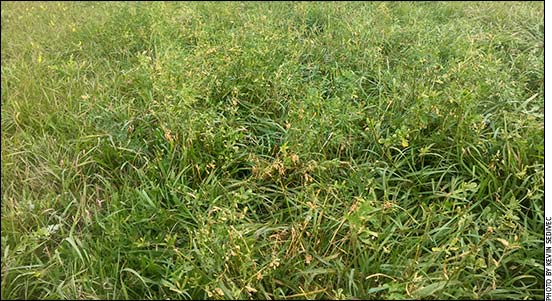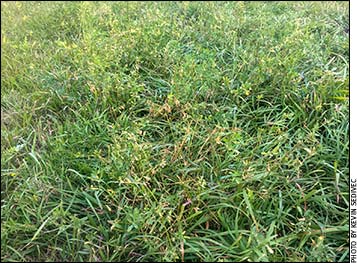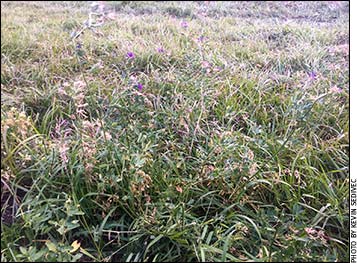
Alfalfa-meadow brome mixes allow for two cuttings per season.
Advantages of Grass-legume Mixes
Research projects in many states have looked at the possible advantages of grass-legume mixtures for hay and pasture.
Kevin Sedivec, professor of range science at the North Dakota State University, has done several trials on grass-alfalfa mixes.
“What works in the Northern Plains is sometimes different than in other areas. We have only two grasses that grow really well with alfalfa, that allow us to get two cuttings per season of a grass-alfalfa mix. These are meadow brome grass and orchard grass. Both will regrow with alfalfa for a second cutting,” he says. “Tall fescue will also do this — but we don’t grow tall fescue this far north. Until there’s a good variety that won’t winter-kill, I can’t recommend it here.”

Alfalfa-meadow brome mixes require a fair amount of water.
Sedivec says meadow brome and orchard grass grow well in the Dakotas and western Minnesota, but they don’t grow as well in Montana and Wyoming. The grasses require a fair amount of water, so they are more limited in drier climates if you want multiple crops.
“In the West, if you have good soils with good water-holding capacity, you can use meadow brome but not orchard grass, because it doesn’t do well in dry situations,” he explains. “[It] also tends to winter-kill without snow cover to protect it. Orchard grass fits best in South Dakota and the southeastern part of North Dakota.”
Those are the two best options for a good grass-alfalfa mix that will last many years.
“We have a stand at the Central Grassland Research Extension Center we seeded in 1988, and it’s still good today. We consistently take two cuttings. It was planted 30 years ago as a 50-50 mix, and today it’s about 60% meadow brome and 40% alfalfa,” he says.
A 50-50 mix has considerable longevity; it doesn’t need replanted very often.
Some producers want more alfalfa in their mix, such as 75%-25% alfalfa-grass, and use a seeding rate to achieve that objective.
“That mix will last five to 10 years, then drops to a 50-50 mix due to alfalfa die-off,” Sedivec says. “If your goal is to always have a 50-50 mixture, a stand can last 20 years or more with that kind of mix and good management.”

With care, alfalfa-grass mixes will last for decades.
Sedivec says the 50-50 mix reduces input costs and is cost-effective.
Producers often wonder if they need to fertilize this kind of stand, he says. “Most people don’t, but if you want to maximize performance with a 50-50 mix, it pays to fertilize it periodically.”
Even though alfalfa is a nitrogen-fixing plant that adds nitrogen to the soil, it only benefits grass that grows within 1 to 3 feet (ft.) of the alfalfa plant. If alfalfa plants are 3 to 5 ft. apart, there will be grasses in those spaces that will be lacking in nitrogen.
Sedivec recommends adding nitrogen to increase fertility and biomass for the grass by the fourth or fifth year after you’ve planted this mix, and then fertilizing every other year thereafter. You don’t have to fertilize as often as if it was just straight grass.
The 50-50 mix makes a good hay crop, and can also be grazed, Sedivec says. “The beauty of a 50-50 mix or less is that cows rarely bloat because they generally select the grass first over the alfalfa when they graze. I don’t want to say that producers don’t have to worry about bloat because there is always a cow or two that seek out the alfalfa and eat more of it. You still have to deal with the timing, being careful when you put the cattle on this type of pasture.”
Researchers at the Central Grassland Research Extension Center remove the first growth as hay in mid-June, then a second cutting in late July if moisture is sufficient.
“We normally get two crops because meadow brome and alfalfa regrow together,” he explains. “After the second cutting we graze the regrowth, usually from mid-October until we think the cattle should come off. You don’t want to graze too short just before winter. We’ve grazed it at a light to moderate rate for almost three decades.”
This same management could also work for an alfalfa-orchard grass mix.

Editor’s Note: Heather Smith Thomas is a cattlewoman and freelance writer from Salmon, Idaho.






